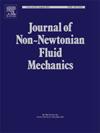Quantitative characterization of the ribbons and elastic vortices in viscoelastic Taylor-Couette flow with Boger fluids
IF 2.8
2区 工程技术
Q2 MECHANICS
引用次数: 0
Abstract
Instabilities modes in viscoelastic Taylor-Couette flow are investigated using space-time diagrams and particle image velocimetry (PIV) of flow patterns in the meridional cross-section. The working solution is an aqueous mixture of the polymer solution of Polyethylene oxide (PEO) and Polyethylene glycol (PEG). The concentrations of the PEG and the POE are chosen in such a way to obtain solutions with constant shear viscosities (characteristic of Boger fluids) and a wide spectrum of values of the molecular elastic number in a single Taylor-Couette system. The interplay between the elasticity of the polymer solution and the inertia forces induced by the rotation of the cylinders leads to different critical modes: stationary Taylor vortices for very small values of the elasticity, ribbons i.e. superposition of spirals of opposite helicity for intermediate values of the elasticity and elastic vortices for large values of the elasticity and weak inertia forces. The elasto-rotational Rayleigh discriminant and linear stability analysis show the role of elasticity in the destabilization of the base flow and on the threshold of critical modes. The elastic vortices are characterized by regions of strong inflows separated by outflows; they form flame patterns in the spatiotemporal diagrams. The amplitude of the radial velocity at the centre of vortices is used as the order parameter of the ribbons dynamics. The Ginzburg-Landau theory offers a framework to describe the destabilization of regular ribbons with the introduction of a dissymmetry parameter. Spatiotemporal properties of elastic vortices (such as the drift velocity, the fraction, the size and the lifetime of inflows) are measured for different values of the criticality. The scaling exponents of energy spectra for inertio-elastic turbulence are determined for viscoelastic Taylor-Couette flow with the inner or outer sole rotating cylinder; the obtained values are compared with those from other experiments and from numerical simulations. PIV measurements have allowed to determine the power of the radial force at the inflow which shows that the driving mechanism of the elastic instability is active from the outer cylinder toward the inner cylinder.
Boger流体粘弹性Taylor-Couette流中带状和弹性涡的定量表征
利用时空图和质点图像测速(PIV)技术研究了粘弹性Taylor-Couette流的不稳定模态。工作溶液是聚氧聚乙烯(PEO)和聚乙二醇(PEG)聚合物溶液的水溶液混合物。PEG和POE的浓度是这样选择的,以获得具有恒定剪切粘度(Boger流体的特征)和单个Taylor-Couette体系中分子弹性数的宽谱值的溶液。聚合物溶液的弹性与圆柱体旋转引起的惯性力之间的相互作用导致了不同的临界模式:弹性值很小的静止泰勒涡,弹性值中等的带状,即相反螺旋度的螺旋叠加,弹性值大而惯性力弱的弹性涡。弹性-旋转Rayleigh判别和线性稳定性分析表明弹性在基流失稳和临界模态阈值上的作用。弹性涡的特征是强流入区被流出区隔开;它们在时空图中形成火焰模式。采用涡旋中心径向速度的幅值作为条带动力学的阶参量。金兹堡-朗道理论提供了一个框架来描述不对称参数引入规则带的不稳定性。在不同的临界值下,测量了弹性涡的时空特性(如漂移速度、分数、流入的大小和寿命)。确定了内底或外底旋转圆柱的粘弹性Taylor-Couette流的惯性-弹性湍流能谱的标度指数;并与其它实验和数值模拟结果进行了比较。PIV测量可以确定流入处径向力的功率,表明弹性失稳的驱动机制是从外筒向内筒活跃的。
本文章由计算机程序翻译,如有差异,请以英文原文为准。
求助全文
约1分钟内获得全文
求助全文
来源期刊
CiteScore
5.00
自引率
19.40%
发文量
109
审稿时长
61 days
期刊介绍:
The Journal of Non-Newtonian Fluid Mechanics publishes research on flowing soft matter systems. Submissions in all areas of flowing complex fluids are welcomed, including polymer melts and solutions, suspensions, colloids, surfactant solutions, biological fluids, gels, liquid crystals and granular materials. Flow problems relevant to microfluidics, lab-on-a-chip, nanofluidics, biological flows, geophysical flows, industrial processes and other applications are of interest.
Subjects considered suitable for the journal include the following (not necessarily in order of importance):
Theoretical, computational and experimental studies of naturally or technologically relevant flow problems where the non-Newtonian nature of the fluid is important in determining the character of the flow. We seek in particular studies that lend mechanistic insight into flow behavior in complex fluids or highlight flow phenomena unique to complex fluids. Examples include
Instabilities, unsteady and turbulent or chaotic flow characteristics in non-Newtonian fluids,
Multiphase flows involving complex fluids,
Problems involving transport phenomena such as heat and mass transfer and mixing, to the extent that the non-Newtonian flow behavior is central to the transport phenomena,
Novel flow situations that suggest the need for further theoretical study,
Practical situations of flow that are in need of systematic theoretical and experimental research. Such issues and developments commonly arise, for example, in the polymer processing, petroleum, pharmaceutical, biomedical and consumer product industries.

 求助内容:
求助内容: 应助结果提醒方式:
应助结果提醒方式:


